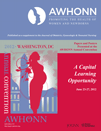Use of a Video-Ethnographic Intervention, PRECESS Immersion Method, to Improve Skin-to-Skin Care and Breastfeeding Rates
Poster Presentation
Objective
Part 1: To describe the rate of exclusive breastfeeding at hospital discharge in healthy mothers and infants who had immediate and uninterrupted skin-to-skin care after vaginal or cesarean birth during a 5-day intervention (Practice, Reflection, Education and Training immersion method) Part 2: To assess for improvements and sustainability in monthly skin-to-skin and exclusive breastfeeding rates.
Design
Part 1: Descriptive, observational, nonexperimental with video-ethnography and interactive analysis (Practice, Reflection, Education and Training combined with ethnography for sustainable success) during a 5-day quality improvement pilot research study. Part 2: Electronic medical record review to test for differences in monthly skin-to-skin and exclusive breastfeeding rates at hospital discharge after the Practice, Reflection, Education and Training intervention.
Setting
Nonprofit private medical center in the southwest United States with 793 beds and 6,000 births per year.
Patients/Participants
Part 1: convenience sample of 11 healthy English-speaking women >18 years, admitted to labor and delivery for vaginal birth or scheduled cesarean. Part 2: electronic medical record review.
Methods
Part 1: descriptive statistics; Practice, Reflection, Education and Training Immersion Method (August 13-17, 2010); barriers and potential solutions identified by staff; comments about skin-to-skin experiences. Part 2: inferential statistics Pearson chi-square to test for significant differences between and among monthly rates of skin-to-skin care and exclusive breastfeeding (95% confidence interval; p < .05) (baseline, July 2010; post-intervention, August-December, 2010).
Results
Part 1: 10 (91%) received immediate and 8 (73%) received uninterrupted skin-to-skin care; 6 (67%) of the infants whose mothers planned to breastfeed went through all nine instinctive stages during skin-to-skin care; 5 (83%) of the 6 infants who went through all nine stages were discharged as exclusively breastfed. Part 2: comparison rates (Pearson chi-square 23.798, df = 5) between and among months showed a significant difference in month-to-month rates (p = .000)
Conclusion/Implications for Nursing Practice
The Practice, Reflection, Education and Training Immersion Method may rapidly improve skin-to-skin care; infants who complete all nine states during skin-to-skin may be more likely to exclusively breastfeed at discharge; mothers need support during skin-to-skin care to recognize their infants’ readiness to breastfeed; staff who are educated about infants’ nine instinctive stages during skin-to-skin may be more effective at providing evidence-based clinical care after birth skin-to-skin care may reduce maternal stress and improve satisfaction, particularly during cesarean surgery.




